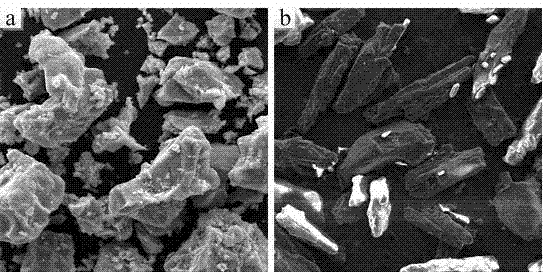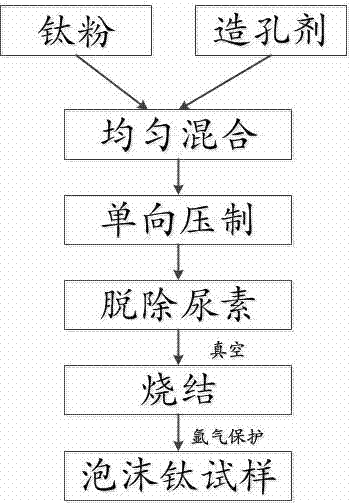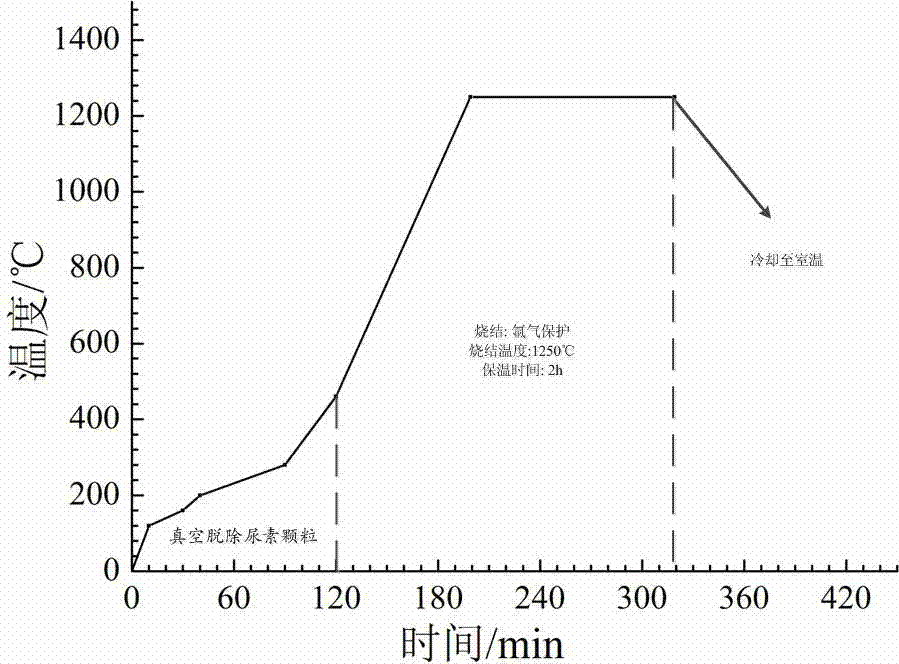Preparation method of titanium foams for cancellous bone
A technology of foamed titanium and cancellous bone, which is applied in the field of foamed titanium materials, can solve the problems of reducing the service life of titanium and titanium alloy implant materials, unfavorable bone tissue growth, and few researches, so as to avoid stress shielding and realize Long-term fixation and simple operation
- Summary
- Abstract
- Description
- Claims
- Application Information
AI Technical Summary
Problems solved by technology
Method used
Image
Examples
Embodiment 1
[0033] Example 1: see figure 2 , a preparation method of titanium foam for cancellous bone, comprising the steps of:
[0034] 1) Mixing of raw materials: select titanium powder and needle-shaped crystal urea particles with a particle size of 225-420 μm to grind and mix to obtain a preliminary mixture, wherein the mass-number ratio of titanium powder and pore-forming agent is 46.6:53.4; titanium powder and the microscopic morphology of urea particles as figure 1 shown. The titanium powder can be purchased directly from the market, and its surface and irregular shape can improve the strength of the green compact on the one hand and facilitate sintering on the other hand.
[0035] 2) The preliminary mixture is unidirectionally pressed into a green compact using a 600KN universal material testing machine, and the green compact is pressed into a cylindrical shape, wherein the unidirectional pressure is 200MPa, and the holding time is 1min.
[0036] 3) The green compact is pl...
Embodiment 2
[0041] Example 2: A method for preparing titanium foam for cancellous bone, comprising the steps of:
[0042] 1) Mixing of raw materials: select titanium powder and needle-shaped crystal urea particles with a particle size of 225-420 μm and mix them in the grinding body to obtain a preliminary mixture, wherein the mass-number ratio of titanium powder and pore-forming agent is 42.8:58.2;
[0043] 2) The preliminary mixture is unidirectionally pressed into a green compact using a 600KN universal material testing machine, and the green compact is pressed into a cylindrical shape, wherein the unidirectional pressure is 200MPa, and the holding time is 1min.
[0044] 3) The green compact is placed in a vacuum carbon tube furnace, sintered at 1250° C. for 2 hours in an argon protective atmosphere to remove the pore-forming agent, and finally cooled with the furnace to obtain foamed titanium.
[0045] The titanium foam prepared in Example 2 has a porosity of 74.2%, a compressive st...
Embodiment 3
[0046] Example 3: A method for preparing titanium foam for cancellous bone, comprising the steps of:
[0047] 1) Mixing of raw materials: select titanium powder and needle-shaped crystal urea granules with a particle size of 225-420 μm and mix them to obtain a preliminary mixture, in which the mass-number ratio of titanium powder and pore-forming agent is 44.1:55.9;
[0048] 2) The preliminary mixture is unidirectionally pressed into a green compact using a 600KN universal material testing machine, and the green compact is pressed into a cylindrical shape, wherein the unidirectional pressure is 250MPa, and the holding time is 1min.
[0049] 3) The green compact is placed in a vacuum carbon tube furnace, sintered at 1300° C. for 2 hours in an argon protective atmosphere to remove the pore-forming agent, and finally cooled with the furnace to obtain foamed titanium.
[0050] The titanium foam prepared in Example 3 has a porosity of 73.6%, a compressive strength of 8.3 MPa, an...
PUM
| Property | Measurement | Unit |
|---|---|---|
| Granularity | aaaaa | aaaaa |
| Compressive strength | aaaaa | aaaaa |
| Young's modulus | aaaaa | aaaaa |
Abstract
Description
Claims
Application Information
 Login to View More
Login to View More - R&D
- Intellectual Property
- Life Sciences
- Materials
- Tech Scout
- Unparalleled Data Quality
- Higher Quality Content
- 60% Fewer Hallucinations
Browse by: Latest US Patents, China's latest patents, Technical Efficacy Thesaurus, Application Domain, Technology Topic, Popular Technical Reports.
© 2025 PatSnap. All rights reserved.Legal|Privacy policy|Modern Slavery Act Transparency Statement|Sitemap|About US| Contact US: help@patsnap.com



